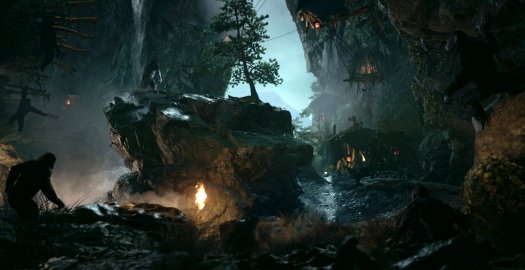Review for Planet of the Apes: Last Frontier

Planet of the Apes and I go way back. Not quite all the way to Charlton Heston and the Statue of Liberty, but far enough that I’ll never be able to picture Roddy McDowall without a monkey mask. (Yes, I know apes aren’t monkeys, but I didn’t when I was eight.) So of course I eagerly anticipated the recent movie trilogy that revived the long-dormant franchise (let’s just all agree to pretend the Burton/Wahlberg debacle never happened), and it didn’t disappoint with its much more grounded, modern-day vision than the future-Earth originals. That made checking out Planet of the Apes: Last Frontier a no-brainer as well, even if I’m a little late to the party. This choice-driven companion story to the new films certainly looks and sounds the part, with stunning production values all around. Unfortunately, “no-brainer” perhaps best describes the overall experience, with its near-total absence of anything resembling gameplay, limited player agency, and a narrative that comes across as little more than a rehash of what came before it. It’s so simple even a non-enhanced bonono could play it and wish for greater challenge.
Last Frontier’s story ostensibly takes place between the 2014 Dawn and 2017 War movies (the second and third, for those of you, like me, who can’t ever keep the names straight), but other than the briefest mention of Caesar in the short narrated intro, no other direct connection is made with the films. Strangely, there’s no attempt to provide any context at all. How have talking apes managed to form an interspecies community in the mountains, isolated from what appears to be just a pocket of surviving human beings in a fortified settlement? You’ll be completely in the dark without the benefit of prior knowledge (pssst: apes were intellectually enhanced by an experimental drug and broke out of captivity while mankind was largely wiped out by the virus it created in people). Since the story that follows is anything but complex and will surely appeal most to existing series fans anyway, very little background is needed, but it’s an odd omission nonetheless.
Other than getting your initial bearings faster, it would probably be best if you’re coming to Last Frontier fresh, as the game feels largely like a stripped-down retelling of Dawn of the Planet of the Apes, just with different characters and settings. This is the story – or rather the dual stories – of a chimp named Bryn and his tribe of fellow simians hiding out in old mining mountain caves not far from Millerton, a small town in the middle of seeming nowhere led by the newly widowed Jess, who assumes the mantle of leadership following the death of her well-respected husband. With both sides scrounging for insufficient resources, it’s inevitable that the two will collide eventually, but there are divisions within each camp competing to decide how that conflict should unfold. There are those who favour aggression and hostility, and those who would seek out more defensive options and perhaps even peaceful solutions.
Interestingly, the game allows you to play out the scenarios for both the apes and humans first-hand, alternating regularly between them. On paper that seems like a smart idea: by providing multiple perspectives, it introduces layers of understanding and complexity that wouldn’t exist by getting just one side of a story. The problem is, by making you responsible for the decisions made by each camp, it’s a lot like playing a game of poker against yourself. When you’re already privy to what the other side is planning to do, there’s no way to distance yourself from what you ought not to know, and therefore no suspense. I’m inclined to believe that the far better option would have been to relate the story completely for one side, and only then flip to the opposition with all previous decisions reset.
The idea still could have worked if not for two main issues. The first is that all choices are completely binary. There are only ever two options, and rarely are they very subtle, basically boiling down to: be a scumbag or not. Some dictate actions (shoot at a fleeing enemy or not? Use a flare as a warning or weapon?) but most involve dialogue and picking who to support and who to reject (endorse Bryn’s bully brother Tola or protect his runt brother Juno? Welcome a pair of shady drifters into Millerton or deny them entry?). While an argument could certainly be made for different approaches, and there is some moral ambiguity on occasion, for the most part once you’ve settled on being a good guy or bad guy, the die is cast. Rarely did I ever struggle to decide between options, nor would I have even if I didn’t know the choices I’d already made on behalf of my counterparts.
Even that might have been enough, except that it soon becomes pretty clear that your choices really don’t matter much. Since I typically only play games once, I’m okay with just an illusion of choice so long as it’s presented effectively, but Last Frontier tipped its hand pretty early that not only was it going to follow its own course regardless of my input, it was going to do so practically right away. The same characters will live or die, the same people will gain or lose power, the same battles will take place. I get that it’s impractical for a game – particularly one as graphically intensive as this one – to have wildly diverging story paths, but at least plant the seed of doubt instead of immediately dispelling the notion of actual player agency. (Note: I only replayed for an hour making all different decisions, so it’s possible that some later sequences are altered somewhat, but I saw nothing to convince me to invest more time in trying to find out.)
About the only reward or punishment for your choices comes in the end-of-chapter summaries indicating the quality of your relationships with those closest to you, but really even these just confirm what you’ll likely already know. I’d expect my relationship with the person I keep rejecting or the ape I keep defying to be awful; how could it be otherwise? The only times I couldn’t easily decide between choice prompts were when I wasn’t clear on what might occur based on my response. Each option is summed up in just a few words or less, and it isn’t always apparent what outcome they might yield. You have only a very limited time before the timer runs out – or so I thought – and a couple times I was forced into a rushed selection whose unintended results I regretted afterwards. Only by accident did I realize that the timer itself is an illusion. Fail to choose in time and the screen will simply freeze until you do. I’m not sure if this is true of every decision, so I continued to try to beat the timer anyway, but a longer time with no failsafe would have probably made more sense.
Unfortunately, the worst example of misleading prompts is also the most crucial. After three hours spent playing through five chapters and a prologue, during which the story mainly did what it wanted to do regardless of my instructions, suddenly the final choice led to the most dire repercussions imaginable. To be fair, it’s framed as arguably the tensest decision of the whole game, but I made my selection with a certain strategy in mind and was completely blindsided by the fact that the plug was pulled then and there, stiffing me with an absolutely horrendous ending. At least there are permanent chapter saves available, so I “only” had to sit through half an hour of unskippable cutscenes to get back to where I was, but it’s a dirty trick to finish the game with such an unexpected outcome when the entire experience to that point has been so predictable.
The failings of the choice-and-consequence system here are paramount, because unlike even the most streamlined of Telltale’s games, this represents the only “gameplay” offered in Last Frontier. Not once will you explore freely, examine hotspots, even decide where to go or who to talk to next. All you ever do is sit and watch and listen, and occasionally use the keyboard arrows or gamepad thumbsticks to highlight one of the two on-screen options available, or once in a while even – gasp – press a button! I’m fine with interactive stories not muddying the waters with ill-fitting puzzles, but there’s no denying that this game would have benefited from at least the occasional change of pace.
If you have to sit and watch something for hours on end (and you do), you really can’t ask for much better than Last Frontier. Sure, it’s nowhere near the level of realism of the films, but by videogame standards the presentation is top-notch. (So long as your computer can handle it, that is, as surprisingly there are no graphics options available.) Locations are fairly limited, but the artwork nicely captures rugged open plains, snow-capped mountains, the human town’s main courtyard, and the inner cave sanctuary of the ape tribe, many of them seen at various times of day with entirely different lighting. Animation is superb and there are no breakaways to cutscenes; the entire game is a collection of engine-driven cinematics, and they’re impressively done. No corners were cut, either. There are some fairly epic gunfights, intense hand-to-hand combat, and a brief but frantic chase scene punctuating the many quieter moments of conversation.
The only place the uncanny valley creeps in slightly is in some of the human models, but even these are perfectly acceptable. Ape fur isn’t particularly convincing, but the presumably-motion-captured gestures, movements and facial features of chimps, gorillas, and of course the requisite lone orangutan most definitely are. The voice acting is spot-on, too. As with the films, the simians here are capable of human speech but communicate largely through grunts and makeshift sign language, only occasionally voicing full sentences. I’ll admit to wishing the balance was a bit more even, but it’s certainly in keeping with its big screen contemporaries. Orchestral music heavy on percussion and strings is frequently prevalent and consistently excellent, though I’d have actually preferred longer periods of silence to give the ambient effects more play. Whenever the screen freezes while waiting for an overdue decision, the score cuts out completely, leaving only the whipping winds or other background noises still running, and it occurred to me how much they were drowned out the rest of the time.
It’s not fair to compare three movies’ worth of Caesar with half a game’s worth of Bryn, but I was still able to enjoy the Last Frontier’s furry protagonist – at least, the version of him I played. I was frustrated by his reticence to be more of a leader, but was buoyed by his unwavering support for family, in particular his weakly brother, his feisty wife and their tiny newborn son. Women lead the way in Millerton, being far more willing to contemplate peaceful alternatives to the men’s itchy trigger fingers (sounds about right), but overall I didn’t much care for anyone on the human side. Granted, we’re not catching them at their best, but I don’t need to play a game to surround myself with constant bickering, sullen teenagers, and fearmongers pushing their own agendas. The story itself is paper-thin: man distrusts ape, ape distrusts man, arguments arise both internally and externally, hostilities escalate on multiple occasions, and the only questions are whether cooler heads will ever prevail and how many will need to die before they do. It works within the limited context of a small slice of postapocalyptic America, but it’s a shame the game doesn’t have anything new to say.
If you’re looking for a full-fledged adventure, you certainly won’t find it in Planet of the Apes: Last Frontier. This is unapologetically an interactive movie through and through. Accept that and there’s a chance you might appreciate what’s offered here. With its big budget production values, the game looks and sounds great as an authentic complement to the recent movie trilogy. Ask any more of it, however, and you’re bound to be disappointed not only by the dearth of actual gameplay, but the lack of significant choices or any real control over how such a familiar story plays out. As a franchise fan I’m certainly not sorry I tried it once, but even with its short length, the prospect of sitting through all the same things just to see the few meagre differences a replay might have in store would surely have me climbing the walls.
WHERE CAN I DOWNLOAD Planet of the Apes: Last Frontier
Planet of the Apes: Last Frontier is available at:
We get a small commission from any game you buy through these links (except Steam).Our Verdict:
“Planet of Aping Better Movies” might be a better title for Last Frontier, a beautiful but barely interactive “us vs. them” tale whose simplistic choices negate the benefit of experiencing the conflict from both sides.




























